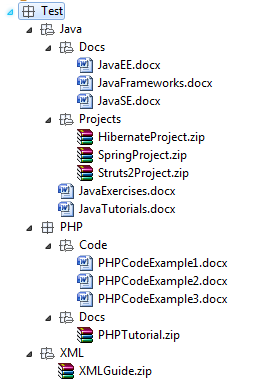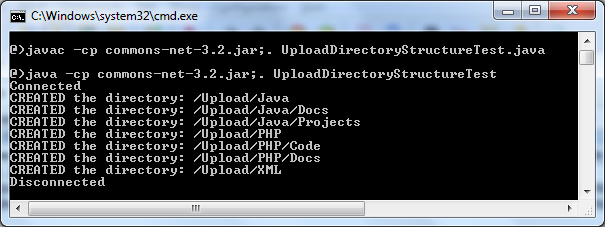Java FTP Upload only structure of a directory to server
- Details
- Written by Nam Ha Minh
- Last Updated on 20 July 2019 | Print Email
import java.io.File;
import java.io.IOException;
import org.apache.commons.net.ftp.FTPClient;
/**
* This utility class provides a method for uploading only structure of a
* directory from local computer to a remote FTP server, based on Apache Commons
* Net library.
*
* @author www.codejava.net
*
*/
public class FTPUploadUtil {
/**
* Upload structure of a directory (without uploading files) to a FTP
* server.
*
* @param ftpClient
* an instance of org.apache.commons.net.ftp.FTPClient class.
* @param remoteDirPath
* Path of the destination directory on the server.
* @param localParentDir
* Path of the local directory being uploaded.
* @param remoteParentDir
* Path of the parent directory of the current directory on the
* server (used by recursive calls).
* @throws IOException
* if any network or IO error occurred.
*/
public static void uploadDirStructure(FTPClient ftpClient,
String remoteDirPath, String localParentDir, String remoteParentDir)
throws IOException {
File localDir = new File(localParentDir);
File[] subFiles = localDir.listFiles();
if (subFiles != null && subFiles.length > 0) {
for (File item : subFiles) {
if (item.isDirectory()) {
String remoteFilePath = remoteDirPath + "/"
+ remoteParentDir + "/" + item.getName();
if (remoteParentDir.equals("")) {
remoteFilePath = remoteDirPath + "/" + item.getName();
}
// create directory on the server
boolean created = ftpClient.makeDirectory(remoteFilePath);
if (created) {
System.out.println("CREATED the directory: "
+ remoteFilePath);
} else {
System.out.println("COULD NOT create the directory: "
+ remoteFilePath);
}
// upload the sub directory
String parent = remoteParentDir + "/" + item.getName();
if (remoteParentDir.equals("")) {
parent = item.getName();
}
localParentDir = item.getAbsolutePath();
uploadDirStructure(ftpClient, remoteDirPath, localParentDir,
parent);
}
}
}
}
}Here is code of the test program:import java.io.IOException;
import org.apache.commons.net.ftp.FTPClient;
public class UploadDirectoryStructureTest {
public static void main(String[] args) {
String server = "www.codejava.net";
int port = 21;
String user = "username";
String pass = "password";
FTPClient ftpClient = new FTPClient();
try {
// connect and login to the server
ftpClient.connect(server, port);
ftpClient.login(user, pass);
// use local passive mode to pass firewall
ftpClient.enterLocalPassiveMode();
System.out.println("Connected");
String remoteDirPath = "/Upload";
String localDirPath = "D:/Test";
FTPUploadUtil.uploadDirStructure(ftpClient, remoteDirPath,
localDirPath, "");
// log out and disconnect from the server
ftpClient.logout();
ftpClient.disconnect();
System.out.println("Disconnected");
} catch (IOException ex) {
ex.printStackTrace();
}
}
}Compile the utility class and the test program:javac -cp commons-net-3.6.jar;. UploadDirectoryStructureTest.java
Run the test program:java -cp commons-net-3.6.jar;. UploadDirectoryStructureTest
If the local directory D:/Test has the following structure: Then the test program will output the following:
Then the test program will output the following:
Related Java FTP File Upload Tutorials:
- Upload files to FTP server using URLConnection class
- How to upload a directory to a FTP server
- Swing application to upload files to FTP server with progress bar
Other Java File Upload Tutorials:
- Java Servlet File Upload Example
- Spring MVC File Upload Tutorial
- Struts File Upload Example
- Java Upload files to database (Servlet + JSP + MySQL)
Other Java FTP Tutorials:
- Connect and login to a FTP server
- Java FTP create directory example
- Java FTP example - Change working directory
- Java FTP list files and directories example
- Java FTP file download tutorial and example
- Java FTP delete file example
- Java FTP example - Search for files and directories
About the Author:
 Nam Ha Minh is certified Java programmer (SCJP and SCWCD). He began programming with Java back in the days of Java 1.4 and has been passionate about it ever since. You can connect with him on Facebook and watch his Java videos on YouTube.
Nam Ha Minh is certified Java programmer (SCJP and SCWCD). He began programming with Java back in the days of Java 1.4 and has been passionate about it ever since. You can connect with him on Facebook and watch his Java videos on YouTube.
Comments